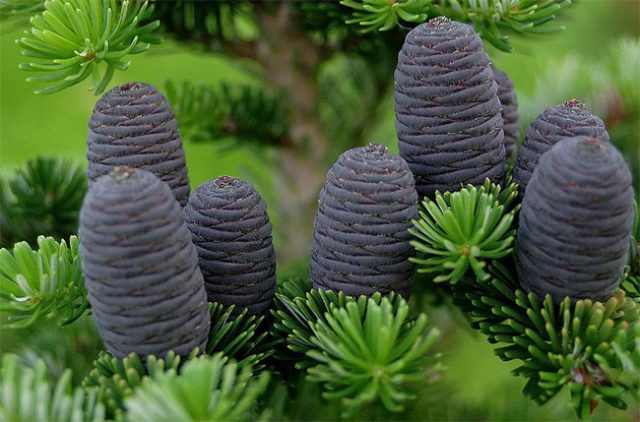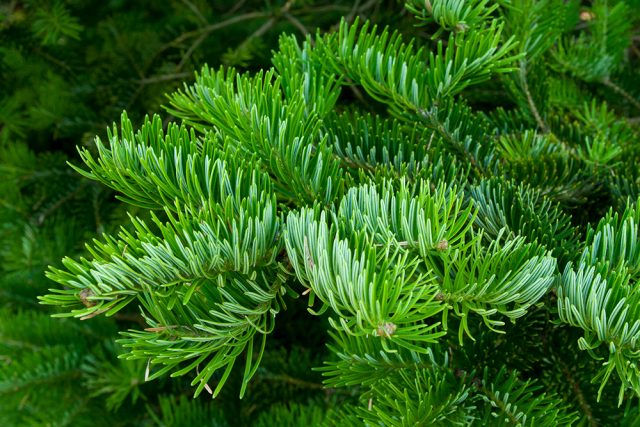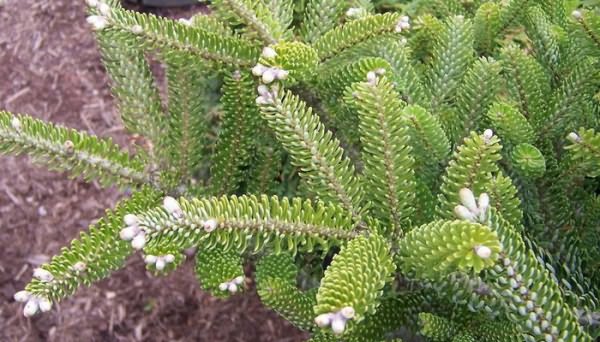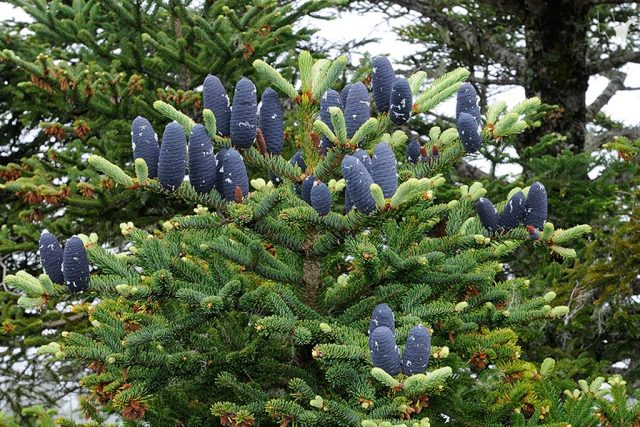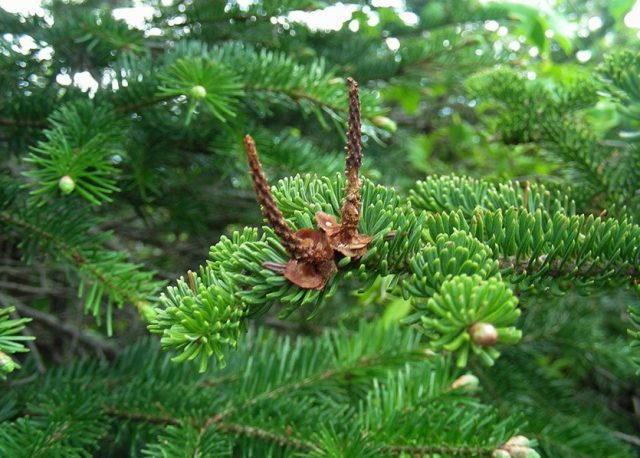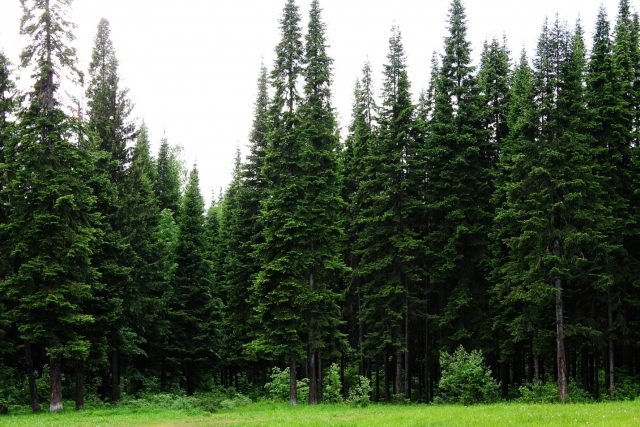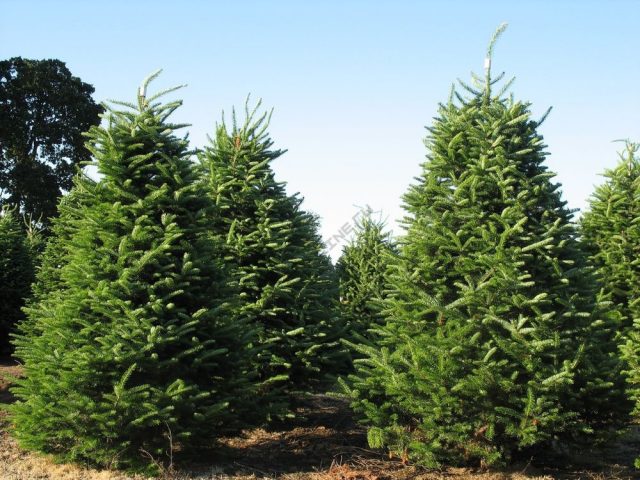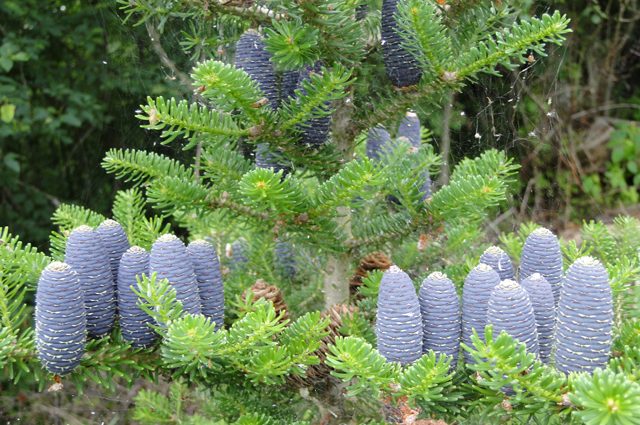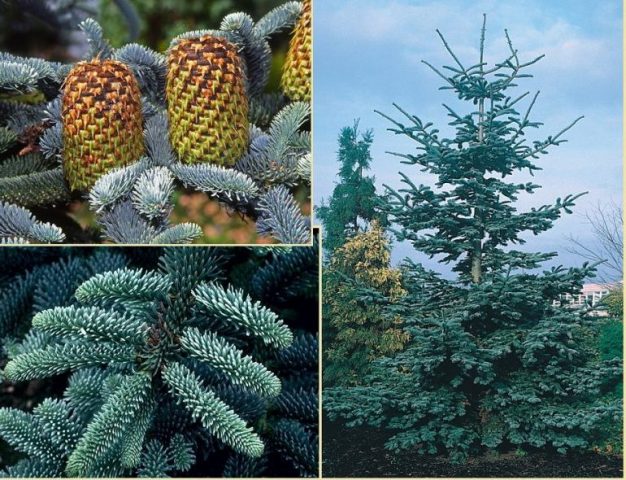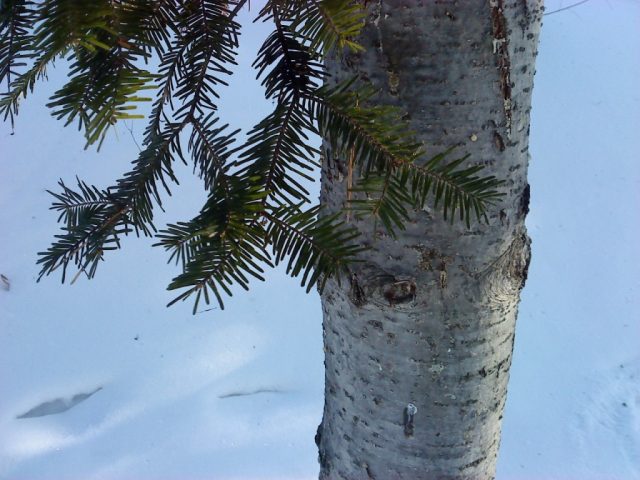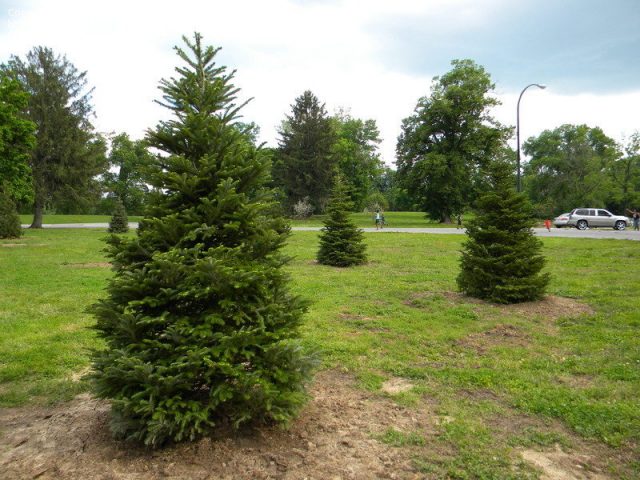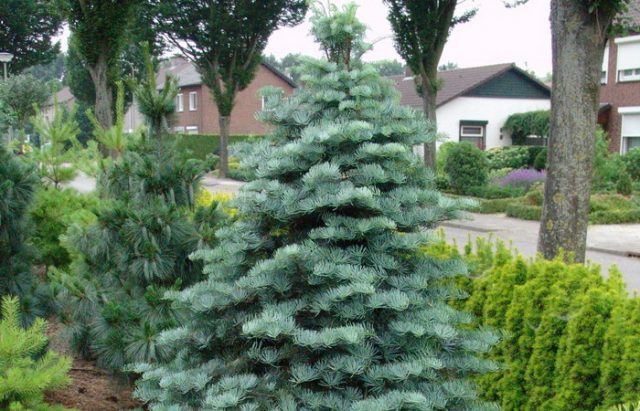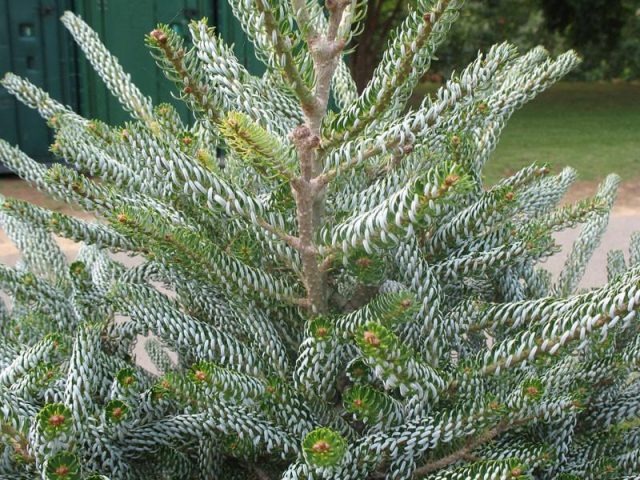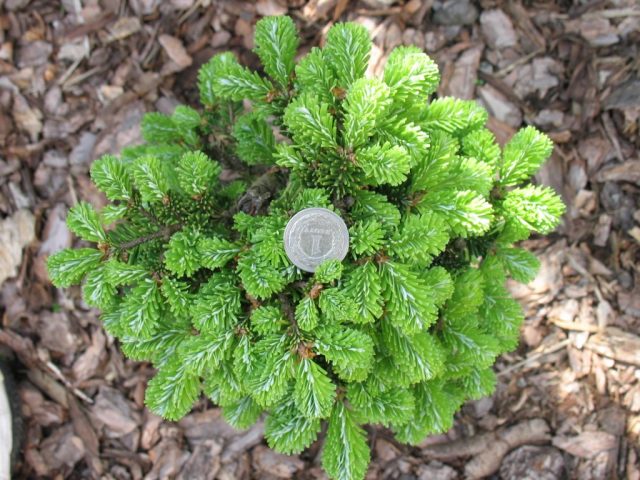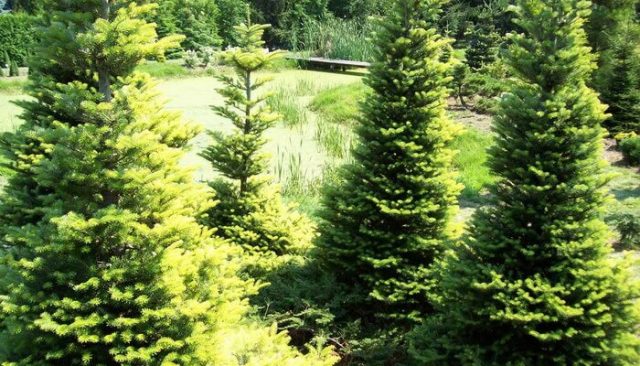Content
- 1 What does a fir tree look like
- 2 Where does fir grow in Russia and in the world
- 3 How does the fir grow
- 4 How many years does a fir live
- 5 Description of fir varieties with photos
- 6 The best varieties of fir for the Moscow region
- 7 Dwarf fir varieties
- 8 Features of planting and caring for fir
- 9 Interesting facts about fir
- 10 Conclusion
The fir looks like a skillfully made craft - a symmetrical crown with clear contours, smooth branches, identical needles. The needles are almost thornless, pleasant to the touch, very beautiful and fragrant. Fir shoots are willingly used by florists, and not only for making bouquets, but also when decorating premises for celebrations.
The breed is also of great economic importance: wood is lumber and is used to make paper, and medicines are made from pine needles and cones. The needles contain essential oils used in medicine and perfumery. Resin is considered by traditional healers as a universal natural substitute for antibiotics.
What does a fir tree look like
Abies or Fir refers to gymnosperms from the Pinaceae family. The genus includes, according to various sources, from 48 to 55 species, often very similar to each other to such an extent that only a specialist can distinguish them.
From a distance, the plant can be mistaken for a spruce, but in fact, the fir in the Pine family is closest to the cedar. Even an ordinary conifer lover will definitely pay attention to the buds growing upward, which is typical for the genera Abies and Cedrus.
Young trees form a crown with a regular conical or hairpin shape. With age, it deforms somewhat, becomes wider, flattened or rounded. All types of fir trees are quite homogeneous and similar to each other, they have one straight trunk, which can bend a little only at high altitudes.
Branching is very dense. Shoots grow strictly in a spiral, making one revolution a year. So you can even determine the exact age of the fir without chopping down the tree in order to count the rings. Branches are located in a horizontal plane, close to the ground, in contact with which they are able to root. Then a new tree grows next to the old fir.
On young trunks and branches, the bark is smooth, thin, penetrated with resin passages that form nodules. Outside, they can be detected by noticeable bulges. In old trees, the bark cracks, becomes thick.
The taproot goes deep into the ground.
What is the height of the fir
The height of an adult fir tree ranges from 10 to 80 m, and depends not only on the species. Plants never reach their maximum size:
- in culture;
- with a poor environmental situation in the region;
- high in the mountains.
It is noteworthy that for the first 10 years the culture grows very slowly, then the rate increases noticeably. The tree grows in size until the end of its life.
The diameter of the crown of a fir growing singly in an open place is usually (but not always) more than 1/3, but less than 1/2 of the height. But in nature, culture often forms dense, dark forests, where trees are located close to each other. There the crown will be much narrower.
The trunk diameter can be from 0.5 to 4 m.
The location and length of the needles in a fir
When identifying species, one of the distinguishing features is the size and location of the fir needles. For all, the common thing is that the needles are single, flat, arranged in a spiral, with two white stripes on the underside. From above they are dark green, glossy.
The tips of the needles can be blunt or serrated, the shape is lanceolate. The needles reach a length of 15 to 35 mm with a width of 1-1.5 mm, rarely up to 3 mm. When rubbed, they emit a pleasant aroma.
The needles stay on the tree for 5 years or more (on average, from 5 to 15 seasons), the longest - in the Cute Fir (Abies amabilis). According to the American Gymnosperms Database, the needles of this species do not fall until 53 years old.
By and large, the fastening of needles on a tree can be divided into three large types, although, in fact, they are still arranged in a spiral.
In addition, the location of the needles on the shoots depends on many factors, namely:
- type of fir;
- the age of the needles;
- the degree of illumination of the shoots.
But amateur gardeners need to know what the needles might look like, because in regions where this crop is rarely grown, they have doubts about the generic affiliation of the tree. Often the owners of private land plots complain: “I bought a fir, but it’s not clear what has grown, its needles must be arranged differently”. So:
- The needles point upward, like the bristles of a toothbrush.
- The needles are fastened in a circle (in fact, in a spiral), like a brush.
- The needles are arranged symmetrically on the twig, like on a two-sided ridge. Most often, such needles are formed on lateral shoots.
Different needles can grow on the same tree. Located inside the crown or on the lower branches devoid of light, the needles in any case will differ from the apical, well-lit ones, and the young ones do not look like mature ones. When identifying species, they are always guided by adult needles.
Falling down, the needles leave a well-visible trace on the shoot, similar to a convex disk.
How the fir blooms
Fir begins to bear fruit in dark forests by the age of 60 or 70. Single trees growing in an open, sunny place bloom twice as early.
Male pollen cones are solitary, but grow in large dense groups on last year's shoots and open in spring. After the release of the pollen, it soon falls off, leaving yellowish convex traces on the branches.
Female flowers are reddish-purple or green, single, located only on the upper part of the crown. They are directed upwards, growing on branches that appeared last season.
What fir cones look like
Fir refers to coniferous trees with cones located strictly vertically. They mature in one season and look very decorative.
Photo of fir with cones
The size, shape and density of fir cones depend on the species. They can be resinous or not very, from ovoid-oblong to cylindrical or fusiform. The length of the cones ranges from 5-20 cm, the young ones can be purple, greenish, reddish, but by the end of the season they turn brown.
As the winged seeds mature, the scales become lignified and fall off. Only the axis of the cone remains on the tree, which looks like a giant thorn. This is best seen in the photo.
Where does fir grow in Russia and in the world
Fir is common in Europe, North America and Africa. On the Asian continent, it grows in South China, the Himalayas, Taiwan.
Only Siberian Fir in Russia and Balsamic Fir from North America live on plains or low hills.The range of the rest of the genus is limited by mountain ranges located in a temperate and subtropical climate.
Russia is home to 10 species of fir, the most common of which is Siberian, the only one of the genus extending beyond the Arctic Circle in the lower reaches of the Yenisei. In the Caucasus, there is a relict Nordman, the Belokoroy area is spread in the mountains of Northern China, the Far East and Korea. Listed in the Red Book of Graceful or Kamchatskaya is limited to the territory of the Kronotsky Nature Reserve (15-20 hectares).
How does the fir grow
Unlike most conifers, fir is demanding on growing conditions. Most species are quite thermophilic, and some do not tolerate frost at all. Only firs growing in the taiga zone differ in relative resistance to low temperatures, but they cannot be compared with other conifers in this regard.
The culture is demanding on soil fertility, needs protection from strong winds, but it is extremely shade-tolerant. She does not tolerate drought or waterlogging. The species tree will not grow in metropolitan areas or where there is any air or groundwater pollution. The varieties are more hardy.
How many years does a fir live
The average life span of specific fir is considered to be 300-500 years. The oldest tree, the age of which is officially confirmed, is the Abies amabilis growing in Baker-Snoqualmie National Park (Washington), she is 725 years old.
Description of fir varieties with photos
Although the culture is considered quite homogeneous, a description of the most common types and varieties of fir with a photo will be useful for amateur gardeners. This way they can get to know the Abies genus better and, if necessary, choose a tree to grow on the site.
Balsam fir
The species grows in Canada and the northern United States. Forms mixed coniferous forests with hemlock, spruce, pine and deciduous trees. Abies balsamea is most often located in the lowlands, but sometimes it rises into the mountains to an altitude of no more than 2500 m.
Balsam fir forms a slender tree 15-25 m high with a trunk 50-80 cm in diameter. The crown is regular, rather narrow, conical or narrow pyramidal.
In detached trees, branches descend to the ground and take root. Several young plants grow next to an adult fir, which looks quite impressive.
The grayish brown bark is smooth, covered with large resinous tubercles. The buds are round, highly resinous. The needles are fragrant, dark green at the top, silvery at the bottom, 1.5-3.5 cm long, lives for 5 years.
The tree begins to bear fruit after 20-30 years and produces a good harvest every 2-3 years. Cones are highly resinous, 5-10 cm long, 2-2.5 cm thick, purple. They ripen, turn brown and usually fall off in September-October. Seeds are winged, 5-8 mm in size, brown with a purple tint.
The species is distinguished by its shade tolerance and relative resistance to air pollution. Balsam fir, unlike other species, has a weak root system and can suffer from wind conditions. The tree lives for 150 to 200 years and hibernates without shelter in zone 3.
Abies fraseri (Fraseri) is closely related to Balsamic Fir, which some botanists do not consider as an independent species. It grows slightly lower, hardy in zone 4, it is heavily affected by pests, but very beautiful.
Siberian fir
In Russia, the species is a forest-forming species for Western Siberia, Altai, Buryatia, Yakutia, and the Urals. Abies siberica grows in the European part in the east and northeast. Distributed in China, Kazakhstan, Kyrgyzstan, Mongolia. It grows both in the mountains, rising to 2400 m above sea level, and in river valleys.
Siberian fir is considered the most hardy species, and withstands frosts down to -50 ° C. It tolerates shade well, rarely lives longer than 200 years due to decay of wood.
Forms a slender tree 30-35 m tall, with a trunk diameter of 50-100 cm and a conical crown.The bark is smooth, greenish-gray to gray-brown, with noticeable resin blisters.
The needles are 2 to 3 cm long and 1.5 mm wide, the outer side is green, at the bottom with two whitish stripes, lives for 7-10 years. The needles have a strong aroma.
Seed cones are cylindrical, 5-9.5 cm long, 2.5-3.5 cm thick. As it ripens, the color changes from bluish to brown. Seeds about 7 mm in size have a wing of the same size or twice as large.
Korean fir
The species was found on Jeju Island, which now belongs to South Korea, in 1907. There, Abies koreana grows in the mountains at an altitude of 1000-1900 m, in a warm climate with a lot of rainfall throughout the year.
The species is distinguished by a rather moderate growth - 9-18 m, a thick trunk, the diameter of which reaches 1-2 m, and high-quality wood. In addition, it is a valuable ornamental crop that has produced many beautiful varieties, including undersized ones.
The bark of the tree is rough, yellowish in youth, covered with a thin nap, eventually acquires a purple hue. Buds are resinous, oval, chestnut to red. The needles are dense, bright green above, bluish-white below, 1-2 cm long, 2-3 mm wide.
Oval cones with a blunt apex appear very early - at 7-8 years old. At first they are colored bluish-gray, then they turn purple-violet, when ripe they turn brown. They reach 5-7 cm in length and 2.5-4 cm in width.
The frost resistance limit is zone 5, the resistance to urban conditions is low. Korean fir lives from 50 to 150 years.
Nordman fir
There are two subspecies of Abies nordmanniana, which some botanists tend to consider as separate species:
- The Caucasian fir (Abies nordmanniana subsp. Nordmanniana), growing west of 36 ° E, is distinguished by its pubescent shoots;
- Turkish fir (Abies nordmanniana subsp. equi-trojani), living east of 36 ° E. with bare branches.
It grows at an altitude of 1200-2000 m and forms pure fir forests, or is adjacent to aspen, oriental spruce, maple, mountain ash.
It is a coniferous tree up to 60 m high with a trunk diameter of 1-2 m. The gray bark is smooth, with oval marks left by fallen branches. Young branches are yellow-green, depending on the subspecies, smooth or pubescent.
The species grows relatively quickly. The buds do not contain resin. The needles, dark green above, silvery below, up to 4 cm long, stay on the tree for 9-13 years. Cones are oval-cylindrical, large, 12-20 cm long, 4-5 cm wide, at first greenish, when ripe they become brown.
The description of the Nordman fir tree cannot convey its beauty - this species is considered one of the most decorative, but varieties are more often used in culture. Hibernates in zone 5, lives for 500 years.
The tree has a strong root system, resistant to wind conditions.
White fir
In Russia, the species Abies nephrolepis is widespread in the Amur Region, the Jewish Autonomous Region, the Primorsky Territory, and in the south of Khabarovsk. Northeast China, North and South Korea are also home to Fir Belokora. Trees grow at an altitude of 500-700 m above sea level in the north of the range, climb up to 750-2000 m along the southern ridges.
It forms a tree with a narrow-conical crown about 30 m high, with a trunk diameter of 35-50 cm. The species got its name thanks to its silvery-gray smooth bark, which darkens with age. The trunk is covered with resin-filled nodules.
The needles are flat, pointed at the end, 1-3 cm long, 1.5-2 mm wide, dark green above, below with two whitish stomatal stripes. The needles are arranged in a spiral, but twisted at the base so that the visual effect of a two-sided ridge is created.
The usual length of seed cones is 4.5-7 cm, width is up to 3 cm. When young, they are green or purple, when ripe they turn gray-brown. Buds are often (but not always) resinous.
The species is shade-tolerant, resistant to low temperatures, trees live 150-180 years.
White fir
The species is often called European or Common Fir. The area is located in the mountains of central and southern Europe, stretches from the Pyrenees to Normandy in the north, includes the Alps and Carpathians, southern Italy, northern Serbia. Abies alba grows at an altitude of 300 to 1700 m.
It is a large coniferous tree with a height of about 40-50, in exceptional cases - up to 60 m.The trunk measured at the height of the chest has a diameter of up to 1.5 m.
The plant forms a conical crown, which rounds off in old age and becomes almost cylindrical, with a blunt, nest-like apex. The bark is smooth, gray, sometimes with a reddish tint, cracks in the lower part of the trunk with age.
The needles are 2-3 cm long, 2 mm wide, obtuse, dark green in the upper part, on the back side there are two clearly visible white stripes. Lives 6-9 years. The buds are ovoid, usually without resin.
Cones are resinous. They appear on the tree after 20-50 years, rather large, oval-cylindrical, with a blunt top, young ones are green, when ripe they become dark brown. The length of the cones reaches 10-16 cm, the thickness is 3-4 cm.
The species is shade-tolerant, very sensitive to air pollution. The tree lives for 300-400 years, overwinters in zone 5.
Vicha fir
This species should be distinguished because Abies veitchii is more resistant to air pollution and has increased requirements for illumination. The Vicha fir grows on the Japanese island of Honshu, where it climbs into the mountains at 1600-1900 m.
The tree grows relatively quickly even at a young age, reaches a height of 30-40 m, forms a loose pyramidal crown. The branches are located in a horizontal plane, the bark is grayish, smooth even in old age.
The needles are dense, soft, curved, up to 2.5 cm long, 2 mm wide. The needles growing inside the crown are shorter and straighter than those located outside. Coloring, like in other species - the upper side is dark green, the reverse seems to be silvery due to two white stripes.
Cylindrical, slightly tapering at the apex, purple-violet buds when young, turn brown when ripe. Their length reaches 4-7 cm. The seeds are yellowish.
The tree lives for 200-300 years, winters in zone three.
Fir Monochrome
One of the most decorative species is Abies concolor, which grows along the Pacific coast of western North America at an altitude of 700-2000 m.In the Rocky Mountains, plants are taken up to 2400-3000 m.
The species is a tree 40-50 m tall with a trunk diameter of 1-1.5 m. By the age of 10 it stretches up to 2.2 m. The crown is symmetrical, beautiful, conical, with low-growing horizontal branches. Only at the end of life does it become rarefied.
The ash-gray bark is thick and cracked. Resinous buds are spherical.
The monochromatic fir got its name due to the uniform color of the needles - on both sides matte, gray-green. The needles are soft and narrow, 1.5-6 cm long, have a strong aroma.
One-color fir bears fruit once every 3 years. Cones are oval-cylindrical, 8-15 cm long with a thickness of 3-4.5 cm. Their color changes from olive green to dark purple, after ripening it turns brown.
This is the most sun-loving species, it tolerates air smoke well, lives up to 350 years. Winters in zone 4. The root system is strong, the tree is not afraid of wind.
The species is very popular in landscape design. As you can see in the photo, fir has blue, evenly colored needles, and this color has always been prized by conifers.
The best varieties of fir for the Moscow region
Although fir is considered a thermophilic crop, it is not difficult to choose a suitable variety for the Moscow region.In order not to create unnecessary problems for yourself, you need to choose trees that can winter in zone 4 or less without shelter.
Dwarf fir varieties for the Moscow region can be planted with less resistance to low temperatures - they can be easily protected from the cold. But there is no special sense in this - the choice is already great, you just need to carefully look at the trees, and not be limited to the first garden center that comes across.
Fir White Green Spiral
An old variety obtained from a mutated twig in 1916 by the Asheville nursery (North Carolina). Abies alba Green Spiral was named Green Spiral only in 1979, previously sold under the name of Tortuos.
The Green Spiral variety is a semi-dwarf coniferous tree with a "crying" crown. Forms a strong central conductor, around which lateral shoots are located in a spiral, bending and drooping.
Fir propagates only by grafting, the shape of the crown and the height of the tree depend on its height, pruning, and the presence or absence of support. The maximum length of the main conductor is 9 m; by the age of 10 without cuttings, it can reach 4 m.
The needles are short, dense, green, below - silvery. Frost resistance - zone 4.
Photo of a fir tree with a drooping crown of the Green Spiral variety
Fir Plain Blue Clok
The very beautiful, herringbone variety Abies concolor Blue Cloak has gained immense popularity, but its origins are unclear. It is believed that the seedling with a unique shape and color was selected in the late 90s of the last century by employees of the University of Michigan.
The monochromatic Blue Klok fir grows rapidly, starting from a young age adding 20 cm each season.At 10 years, the tree reaches 2 m in height and 1.3 m in width.
The crown shape is very similar to the classic spruce. From a strong straight trunk, shoots slightly rising at the ends, curved in an arc or gently sagging in the middle part, branch off. The needles are thin, soft, pale blue.
The tree should be planted in a sunny location and ensure good drainage. The Blue Cloak variety winters without shelter in the fourth zone of frost resistance.
Fraser Fir Cline's Nest
Some biologists would classify the compact Abies fraseri Klein's Nest as a balsamic fir, since the question of whether Fraser's species is independent remains open. The variety was introduced to the public by the Pennsylvania nursery Raraflora in 1970.
This fir is remarkable in that it grows small, but gives cones. This only adds to the decorative effect of an already attractive tree. The variety grows slowly, adding 6-10 cm per year, by the age of 10 it reaches a maximum of 1 m in height with a crown diameter of 60 cm.
The needles of the Klein's Nest variety are glossy green, noticeably shorter than that of the species tree, the cones are purple. Grows without cover in zone 4.
Korean fir Silberlock
The name of the dwarf variety Abies koreana Silberlocke translates as Silver Curls. It was bred by Gunther Horstmann from Germany in 1979. The correct name of the variety is Horstmanns Silberlocke, as its creator insists, but the abbreviated name stuck and is used by many nurseries.
Silverlock is an amazingly beautiful Korean fir. The needles curl towards the top of the shoot, exposing the silvery underside of the flat needles. The annual growth is 10-15 cm.
On an adult tree, the needles twist less, but still bend a little, revealing the silvered underside of the needles. The crown of the Silverlock fir forms a conical, symmetrical. The cultivar winters in zone 4 without shelter.
Siberian fir Liptovsky Hradok
The spherical fir Abies sibirica Liptovsky Hradok is a relatively new variety created from a witch broom found by Edwin Smith's nursery (Netherlands) in 2009. Today, it remains quite rare and expensive, since it reproduces only by vaccination. Why the variety of Siberian fir, created by a Dutch breeder, is named after a city from Slovakia, even the compilers of catalogs are perplexed.
Liptovsky Hradok forms a compact, irregular crown, which for some reason is called spherical. It is impossible to create a ball out of it without pruning, which, by the way, the firs do not tolerate very well. But the tree is so charming and invariably attracts attention.
Fir adorns not only short, unequal lengths of light green needles, but also large, round, light brown buds. The variety is considered one of the most winter-hardy and miniature - at 10 years old it barely reaches a size of 30 cm, and hibernates in zone 2 without shelter.
Fir Lithuanian Hradok suffers greatly from the heat, it is not recommended to plant it in the 6th zone. In the fifth, you should choose a place protected from the sun and drying wind.
Dwarf fir varieties
Low-growing fir varieties are traditionally in high demand. They can be placed even in the smallest garden, and on a large plot, tiny trees usually decorate the front area. Since fir is a large plant, the height of which is measured in tens of meters, real dwarfs are obtained exclusively from witch brooms and propagated by grafts. Therefore, such trees are expensive, and the variety you like can be searched for on sale for a long time.
Nordmann Fir Berlin
From a witch's broom found in 1989, German breeder Gunther Ashrich bred Abies nordmannniana Berlin. Often the word Dailem or Dalheim is added to the name, indicating the place of origin of the tree, but this is wrong. Lovers should know that they are the same variety.
Berlin is a real dwarf fir with a flattened spherical crown. The branching is multilayer, dense, the needles are short, tough. The upper part of the needles is green, the lower one is silvery.
The annual growth is about 5 cm, in 10 years the fir will reach a height of 30 cm and a width of 60 cm. The variety is adapted for growing in full sun, withstands urban conditions satisfactorily. Fir Berlin overwinters in zone 4.
Fir White Pygmy
An extremely attractive dwarf variety of white fir, clearly obtained from a witch's broom, the origin of which is unknown. For the first time, the description of Abies alba Pygmy was given in the catalog of the Dutch kennel Wiel Linssen of the 1990 release.
White fir Pygmy forms a more or less rounded crown with green and shiny needles in the upper part, silvery underneath. Since the branches are raised up, an interesting visual effect is created, which is clearly visible in the photo.
The annual growth is 2.5 cm or less, by the age of 10, the fir forms a ball, the diameter of which is about 30 cm at best. The variety winters in the fourth zone.
Balsam Fir Bear Swamp
The miniature cute balsam fir got this name because of the place where the witch's broom was found, which gave rise to the variety. The creator of the cultivar, the famous American breeder Greg Williams, claims that Abies balsamea Bear Swamp is one of his best varieties.
Balsam Fir Bear Swamr first forms a rounded crown. Over time, the tree stretches and gradually the contours become tapered. The needles are dark green, short.
The Bear Swamp fir variety is a real gnome that grows extremely slowly. Over the year, the size of the tree increases by 2.5 cm.At 10 years, the height and diameter reach 30 cm.
Fir can be grown without shelter for the winter in zone 3.
Vicha Kramer Fir
The variety was created from a witch's broom by the German nursery Kramer, after which it was named. Abies veitchii Kramer reproduces only by grafting and is a tiny, symmetrical tree.
Fir growth is only 5 cm per season. At 10 years old, the tree reaches a height of 40 cm and a width of 30 cm. Young needles are light green, decorated with white stripes on the reverse side, by the end of summer it darkens a little, but not as much as in the species Vich fir.
The variety is quite winter-hardy in zone 3.
Siberian fir Lukash
A miniature Polish variety of fir, created from a mutated seedling, and not like most dwarfs, by cloning a witch's broom.Authorship belongs to Andrzej Potrzebowski. Siberian fir Lukash was released for sale by the nursery of Janusz Shevchik.
Experts believe that the variety is similar in structure to the famous Canadian Konica spruce. The fir forms a very dense tree with a narrow conical crown, and shoots directed upwards at an acute angle to the trunk.
The needles are tough, light green. At 10 years old, the tree reaches a height of 1 m with a crown diameter of 50 cm. The Siberian fir variety Lukash is distinguished by high winter hardiness, intended for zone 2.
Features of planting and caring for fir
Fir is a more demanding crop than most conifers. It grows on fertile soils, does not tolerate waterlogging or drying out of the soil. When looking for a place for a tree, you need to pay attention to how much light it needs, focusing on the description of the variety, and not just the species.
Not all firs can withstand wind, but the description of the varieties does not say this. So it is better to place the tree in a protected place, especially tall or medium-sized.
When planting fir, drainage is essential. If it is not placed on the bottom of the pit with a layer of at least 20 cm, it will most likely lead to the death of the tree. The approximate composition of the soil mixture for fir:
- leaf humus;
- clay;
- peat;
- sand.
The ratio of the components is 3: 2: 1: 1.
In addition, 250-300 g of nitroammophoska and a bucket of rotted sawdust are introduced into each planting hole. Fresh ones will lead to the death of fir - they will begin to rot right in the ground and burn the root. If there is no sawdust, you need to get it. Or plant a different culture. Of course, rotted sawdust can be replaced with worked-out high-moor peat, but it still needs to be found, the usual one will not work. Coconut fiber or sphagnum moss will do, but this will be too expensive.
Fir also needs to be watered regularly, but not brought to waterlogging, fed, mulched. Only young trees planted in this or last season are sheltered for the winter.
Trees from 5 to 10 years old take root best. It is these seedlings that most often go on sale.
The most common causes of the death of fir trees are inadequate care, overflow and air pollution. This culture, although considered unpretentious, is actually very sensitive.
Among the pests, it is worth highlighting:
- fir moth;
- Siberian silkworm;
- butterfly Nun;
- spruce-fir hermes.
Fir, especially North American species or varieties derived from them, suffers greatly from temperature changes during the day and at night. In the worst case, it can even lead to the death of the tree.
Interesting facts about fir
The bark of the culture is used in the manufacture of balsam, and the needles and young branches are used for fir oil.
Freshly cut branches contain so many phytoncides that they can destroy microbes in the room.
Fir has a strong aroma, but it is completely unlike spruce.
The branches make excellent bath brooms.
In times of famine, the bark was crushed and bread was baked - it was not very tasty and nutritious, but it allowed to hold out.
Fir is easily propagated by layering. Often, the branches simply lay on the ground and take root.
The culture grows in Siberia, the Far East and the Urals, but is rarely found in central Russia.
In fir forests, there is practically no undergrowth, since the branches of the main breed begin to grow very low.
The Trojan horse was made from the Kefalinian fir.
It is believed that the branches of this tree protect against witchcraft and help the dead in the other world.
Conclusion
Fir looks majestic, has many excellent varieties. Particularly attractive in culture is the symmetrical crown, beautiful, as if artificial needles, and purple or green cones directed vertically upward.The spread of fir is restrained only by its low resistance to anthropogenic pollution.
